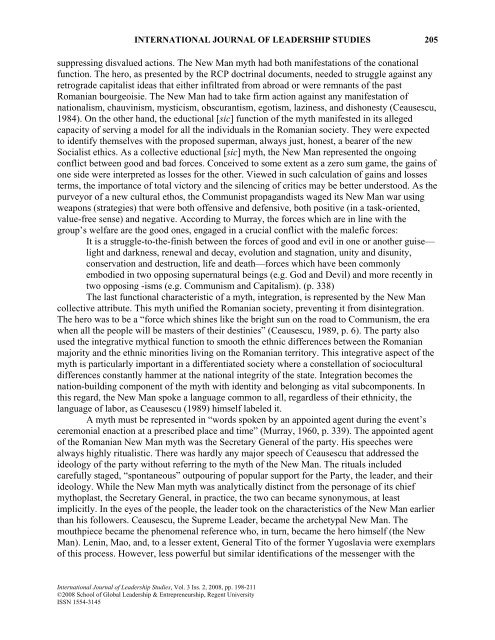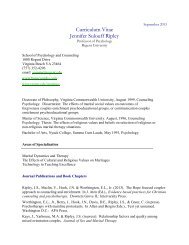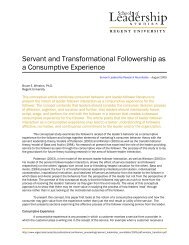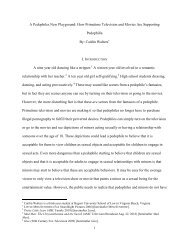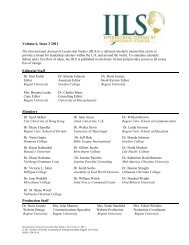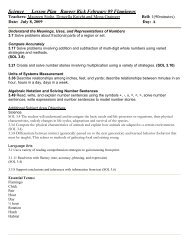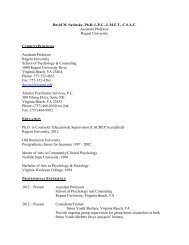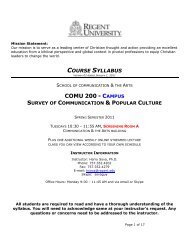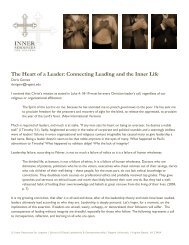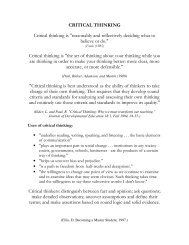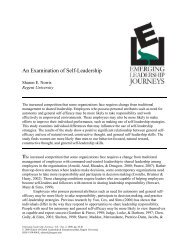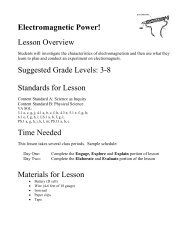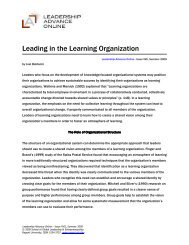Edifying the New Man: Romanian Communist ... - Regent University
Edifying the New Man: Romanian Communist ... - Regent University
Edifying the New Man: Romanian Communist ... - Regent University
Create successful ePaper yourself
Turn your PDF publications into a flip-book with our unique Google optimized e-Paper software.
INTERNATIONAL JOURNAL OF LEADERSHIP STUDIES 205<br />
suppressing disvalued actions. The <strong>New</strong> <strong>Man</strong> myth had both manifestations of <strong>the</strong> conational<br />
function. The hero, as presented by <strong>the</strong> RCP doctrinal documents, needed to struggle against any<br />
retrograde capitalist ideas that ei<strong>the</strong>r infiltrated from abroad or were remnants of <strong>the</strong> past<br />
<strong>Romanian</strong> bourgeoisie. The <strong>New</strong> <strong>Man</strong> had to take firm action against any manifestation of<br />
nationalism, chauvinism, mysticism, obscurantism, egotism, laziness, and dishonesty (Ceausescu,<br />
1984). On <strong>the</strong> o<strong>the</strong>r hand, <strong>the</strong> eductional [sic] function of <strong>the</strong> myth manifested in its alleged<br />
capacity of serving a model for all <strong>the</strong> individuals in <strong>the</strong> <strong>Romanian</strong> society. They were expected<br />
to identify <strong>the</strong>mselves with <strong>the</strong> proposed superman, always just, honest, a bearer of <strong>the</strong> new<br />
Socialist ethics. As a collective eductional [sic] myth, <strong>the</strong> <strong>New</strong> <strong>Man</strong> represented <strong>the</strong> ongoing<br />
conflict between good and bad forces. Conceived to some extent as a zero sum game, <strong>the</strong> gains of<br />
one side were interpreted as losses for <strong>the</strong> o<strong>the</strong>r. Viewed in such calculation of gains and losses<br />
terms, <strong>the</strong> importance of total victory and <strong>the</strong> silencing of critics may be better understood. As <strong>the</strong><br />
purveyor of a new cultural ethos, <strong>the</strong> <strong>Communist</strong> propagandists waged its <strong>New</strong> <strong>Man</strong> war using<br />
weapons (strategies) that were both offensive and defensive, both positive (in a task-oriented,<br />
value-free sense) and negative. According to Murray, <strong>the</strong> forces which are in line with <strong>the</strong><br />
group’s welfare are <strong>the</strong> good ones, engaged in a crucial conflict with <strong>the</strong> malefic forces:<br />
It is a struggle-to-<strong>the</strong>-finish between <strong>the</strong> forces of good and evil in one or ano<strong>the</strong>r guise—<br />
light and darkness, renewal and decay, evolution and stagnation, unity and disunity,<br />
conservation and destruction, life and death—forces which have been commonly<br />
embodied in two opposing supernatural beings (e.g. God and Devil) and more recently in<br />
two opposing -isms (e.g. Communism and Capitalism). (p. 338)<br />
The last functional characteristic of a myth, integration, is represented by <strong>the</strong> <strong>New</strong> <strong>Man</strong><br />
collective attribute. This myth unified <strong>the</strong> <strong>Romanian</strong> society, preventing it from disintegration.<br />
The hero was to be a “force which shines like <strong>the</strong> bright sun on <strong>the</strong> road to Communism, <strong>the</strong> era<br />
when all <strong>the</strong> people will be masters of <strong>the</strong>ir destinies” (Ceausescu, 1989, p. 6). The party also<br />
used <strong>the</strong> integrative mythical function to smooth <strong>the</strong> ethnic differences between <strong>the</strong> <strong>Romanian</strong><br />
majority and <strong>the</strong> ethnic minorities living on <strong>the</strong> <strong>Romanian</strong> territory. This integrative aspect of <strong>the</strong><br />
myth is particularly important in a differentiated society where a constellation of sociocultural<br />
differences constantly hammer at <strong>the</strong> national integrity of <strong>the</strong> state. Integration becomes <strong>the</strong><br />
nation-building component of <strong>the</strong> myth with identity and belonging as vital subcomponents. In<br />
this regard, <strong>the</strong> <strong>New</strong> <strong>Man</strong> spoke a language common to all, regardless of <strong>the</strong>ir ethnicity, <strong>the</strong><br />
language of labor, as Ceausescu (1989) himself labeled it.<br />
A myth must be represented in “words spoken by an appointed agent during <strong>the</strong> event’s<br />
ceremonial enaction at a prescribed place and time” (Murray, 1960, p. 339). The appointed agent<br />
of <strong>the</strong> <strong>Romanian</strong> <strong>New</strong> <strong>Man</strong> myth was <strong>the</strong> Secretary General of <strong>the</strong> party. His speeches were<br />
always highly ritualistic. There was hardly any major speech of Ceausescu that addressed <strong>the</strong><br />
ideology of <strong>the</strong> party without referring to <strong>the</strong> myth of <strong>the</strong> <strong>New</strong> <strong>Man</strong>. The rituals included<br />
carefully staged, “spontaneous” outpouring of popular support for <strong>the</strong> Party, <strong>the</strong> leader, and <strong>the</strong>ir<br />
ideology. While <strong>the</strong> <strong>New</strong> <strong>Man</strong> myth was analytically distinct from <strong>the</strong> personage of its chief<br />
mythoplast, <strong>the</strong> Secretary General, in practice, <strong>the</strong> two can became synonymous, at least<br />
implicitly. In <strong>the</strong> eyes of <strong>the</strong> people, <strong>the</strong> leader took on <strong>the</strong> characteristics of <strong>the</strong> <strong>New</strong> <strong>Man</strong> earlier<br />
than his followers. Ceausescu, <strong>the</strong> Supreme Leader, became <strong>the</strong> archetypal <strong>New</strong> <strong>Man</strong>. The<br />
mouthpiece became <strong>the</strong> phenomenal reference who, in turn, became <strong>the</strong> hero himself (<strong>the</strong> <strong>New</strong><br />
<strong>Man</strong>). Lenin, Mao, and, to a lesser extent, General Tito of <strong>the</strong> former Yugoslavia were exemplars<br />
of this process. However, less powerful but similar identifications of <strong>the</strong> messenger with <strong>the</strong><br />
International Journal of Leadership Studies, Vol. 3 Iss. 2, 2008, pp. 198-211<br />
©2008 School of Global Leadership & Entrepreneurship, <strong>Regent</strong> <strong>University</strong><br />
ISSN 1554-3145


